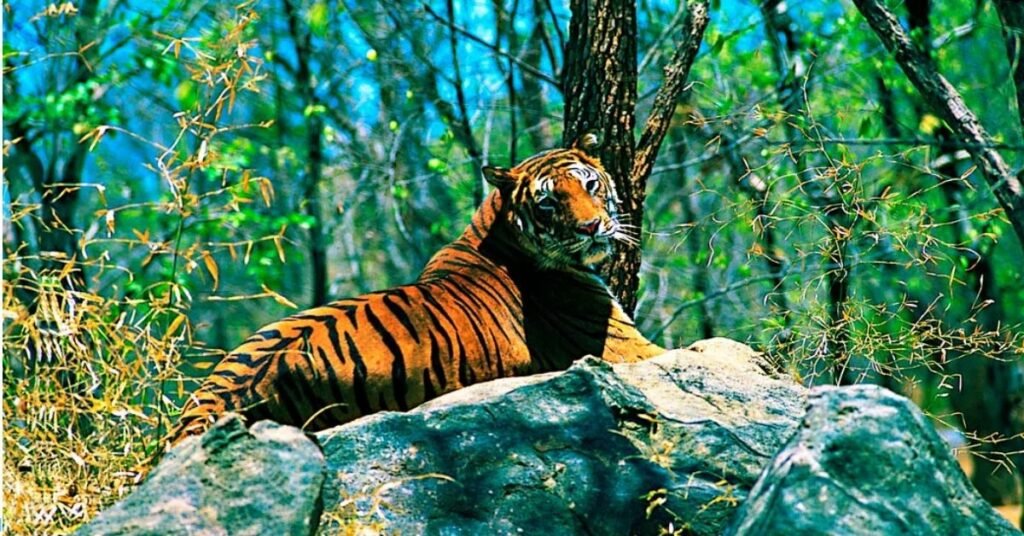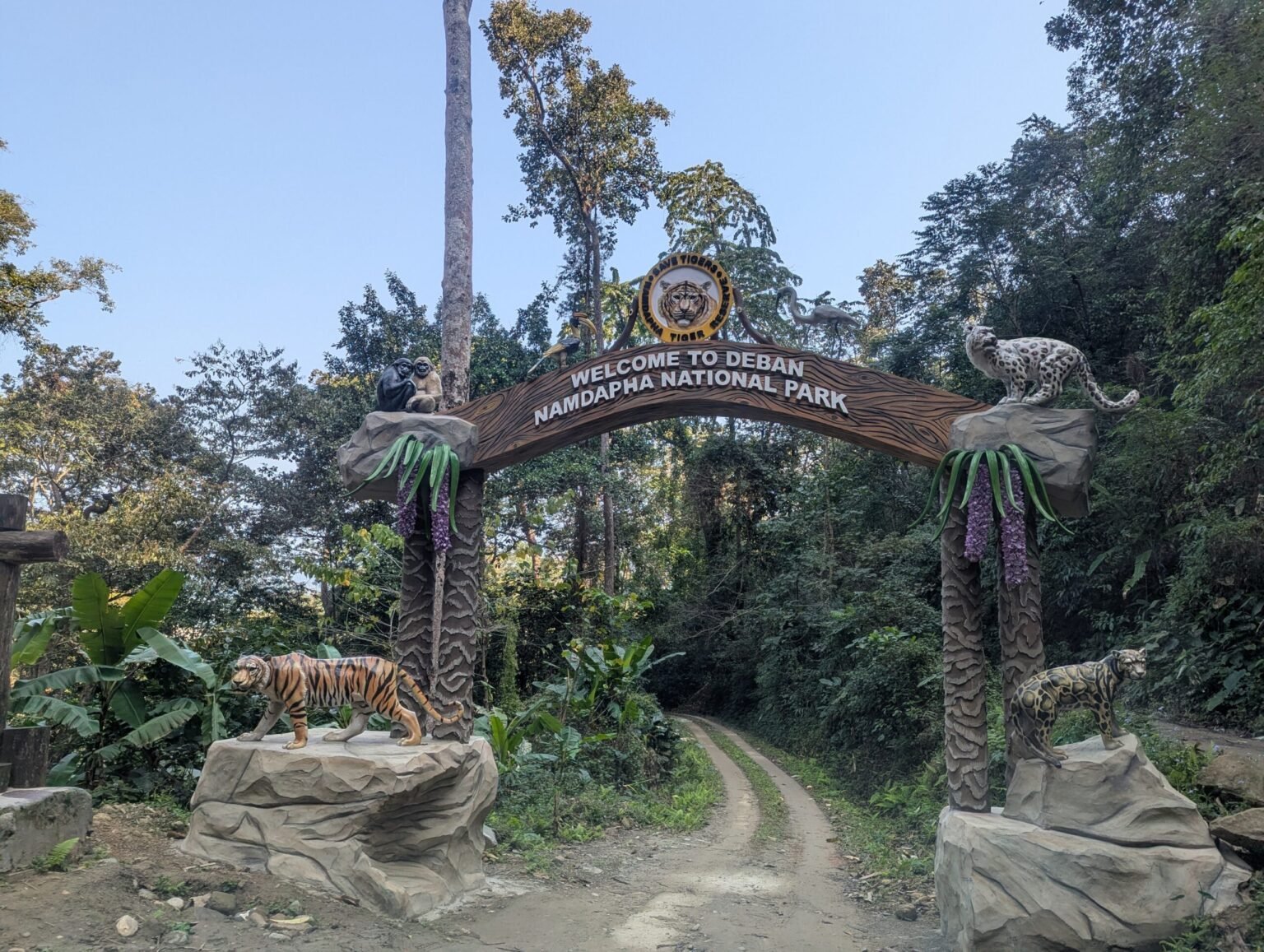Namdapha National Park is a sprawling natural jewel in Northeast India, celebrated for its extraordinary biodiversity, lush landscapes, and vibrant local culture.
Nestled in the misty blue hills of Arunachal Pradesh, Namdapha National Park is India’s fourth-largest national park, stretching over 1,985 square kilometres along the tumultuous Noa-Dihing river. Located near the India-Myanmar border in Changlang district, the park is a true sanctuary for wildlife and nature lovers, offering pristine, untouched wilderness.
Geography and Location
Situated between the Dapha Bum range of the Mishmi Hills and the Patkai range, Namdapha National Park lies at coordinates 27°29′00″N 96°23′00″E. Elevations in the park span from 200 meters to 4,571 meters, nurturing a kaleidoscopic array of landscapes, from lowland evergreen rainforest to snowy alpine meadows.
- Area: 1,985.23 sq. km
- District: Changlang, Arunachal Pradesh
- Nearest Town: Miao, serving as the gateway to the park
How to Reach Namdapha National Park
Namdapha is well-connected by air, rail, and road, though last-mile access involves wilderness travel that is an adventure itself.
- By Air: Nearest airport is Dibrugarh, Assam (182 km).
- By Rail: Tinsukia Railway Station, Assam (140 km).
- By Road: Taxis and buses run from Tinsukia or Dibrugarh to Miao; from Miao, jeeps take visitors to the park.
- The journey involves rugged roads through forested hills, with the last stretch from Miao to Deban often requiring a local jeep or pickup.
Key Details:
| Category | Details |
|---|---|
| Location | Changlang District, Arunachal Pradesh, India |
| Nearest Town | Miao |
| Area | 1,985 sq. km |
| Elevation Range | 200 m to 4,571 m above sea level |
| Major Rivers | Noa-Dihing, Namdapha |
| Main Entry Point | Deban (via Miao) |
| Park Status | National Park & Tiger Reserve |
| Established | Wildlife Sanctuary (1972), National Park & Tiger Reserve (1983) |
| Flora Highlights | >1,000 plant species, orchids, Pinus merkusi, Abies delavavi |
| Fauna Highlights | Tigers, Leopards, Clouded Leopards, Snow Leopards, Hoolock gibbon, elephants, 425+ bird species |
| Tribal Communities | Lisu (Yobin), Chakma, Adi, Mishmi |
| Major Tourist Spots | Deban, Haldibari, Firmbase, Miao, Hornbill, Bulbulia, Moti Jheel, Gandhigram |
| Activities | Trekking, camping, birdwatching, wildlife safaris, photography, tribal village tours |
| Accommodation | Forest rest houses, eco-camps, homestays (mainly in Deban, Miao) |
| Permits | Inner Line Permit (Indians), Protected Area Permit (Foreigners) |
| Entry Fees | Indians: ₹100; Foreigners: ₹500; Children: Free; Camera/Equipment: Extra |
| Best Visiting Time | October to April |
| Park Timings | 6:00 AM to 5:00 PM |
| How to Reach | Air: Dibrugarh (182 km); Rail: Tinsukia (140 km); Road: Buses/cabs to Miao, then local transport |
| Annual Visitors (approx.) | Thousands annually (seasonal peaks) |
| Average Travel Cost (2D/1N) | Budget: ₹4,000–₹6,000 (per person, including transport, stay, permits, and food) |
| Special Notes | Monsoon (June-Sept) is discouraged due to heavy rains and road closures |
History and Evolution
Namdapha’s conservation journey began when it was declared a wildlife sanctuary in 1972. By 1983, it was elevated to the status of national park as well as a Tiger Reserve under India’s Project Tiger initiative. The name ‘Namdapha’ originates from the Singpho language: “nam” for water and “dapha” for origin, signifying its role as the birthplace of rivers and life in the rainforest.
In 2024, Namdapha was declared an Eco-Sensitive Zone, reinforcing its value as a critical habitat deserving the highest level of protection.
Biodiversity: Flora and Fauna
Namdapha is a biodiversity hotspot of global importance.
Flora
- Home to over 1,000 plant species, including 150 species of timber and rare orchids like the Blue Vanda.
- This area features the only Indian populations of Pinus merkusi and Abies delavavi conifers.
- Forests range from tropical rainforests to temperate, alpine forests.
Fauna
- Houses around 1,400 animal species, including the legendary four big cat species found together nowhere else: the Tiger, Leopard, Clouded Leopard, and Snow Leopard.
- Rare mammals include the Namdapha flying squirrel (critically endangered), the hoolock gibbon (the only ape in India), elephants, the Indian bison, and the black bear.
- Over 425 bird species, with rare finds like white-winged wood ducks, five hornbill species, and more than 250 butterfly species.
Faunal Group Species Table:
| Group | Species Count |
|---|---|
| Mammals | 96 |
| Birds | 453 |
| Reptiles | 50 |
| Amphibians | 25 |
| Butterflies/Moths | 140 |
| Fish | 76 |
| Insects | 430 |
| Earthworms | 10 |
| Leeches | 5 |
| Total | 1285 |
Cultural Heritage and Local Tribes
Namdapha’s rich natural world is deeply intertwined with the cultural traditions of the indigenous tribes, such as the Lisu (Yobin), Chakma, Adi, and Mishmi communities.
Festivals and Beliefs:
- The Mopin (Adi) and Chhewu (Mishmi) festivals celebrate the rhythms of nature, blending rituals, music, and feasts.
- Animist beliefs view forests, rivers, and animals as spiritual beings, underpinning strong conservation values.
- Traditional arts include bamboo weaving, wood carving, and beadwork, all inspired by the flora and fauna surrounding their homes.
- The cuisine is centred around forest products, fish, rice, millet, and wild meats, all flavoured with local herbs.

Popular Tourist Spots and Attractions
Namdapha is a paradise for eco-tourists, adventure enthusiasts, birdwatchers, and cultural explorers alike.
1. Deban: Riverside forest camp and base for trekking and birdwatching expeditions on the Noa-Dihing.
2. Haldibari: Scenic camping location, accessible via boat, renowned for its immersive jungle camping experience.
3. Firmbase: A nature lover’s retreat, surrounded by vibrant forest; ideal for wildlife sighting and camping.
4. Miao: Gateway town with cultural museums and Buddhist monasteries, perfect for experiencing local culture.
5. Hornbill: Famed for large flocks of hornbills flying between groves; a birdwatcher’s hotspot.
6. Bulbulia and Camera Point: Great for camping and breathtaking panoramic forest views; Bulbulia is also known for the wildlife around its springs.
7. Moti Jheel and Raja Jheel: Large forest-encased lakes for tranquil wildlife watching and grazing pastures.
8. Gandhigram: Remote village home of the Lisu tribe, offering an authentic glimpse into their way of life; accessed by a challenging trek from Deban.
Nearby Attractions: Lake of No Return, Raja Rani Hill, trekking trails, and tribal villages.
Tourism, Revenue, and Visitor Experience
Visitor Data and Revenue
Tourist numbers to Namdapha vary seasonally, peaking between October and April. Most visitors are domestic, with international arrivals limited due to permit restrictions and remoteness.
- Entry fees: Indians: ₹100, Foreigners: ₹500, children free; Cameras extra.
- Estimated annual economic value: Government studies estimate willingness-to-pay (WTP) for conservation at around ₹350 per visitor. With over 190,000 tourist arrivals in the state in 2012, tourism generated nearly ₹67.85 million/year for environmental management projects.
Facilities and Activities
- Accommodation: Forest guesthouses, camping at Deban, Gandhigram, or riverbanks.
- Permits: Foreigners need a Protected Area Permit (PAP) or Inner Line Permit (ILP), which can be obtained online or in Miao.
Activities: Trekking, wildlife safaris, river angling, birdwatching, nature photography, tribal village tours, boat rides on Noa-Dihing.
Best Time to Visit
Optimal Season: October to April. Avoid June–September due to heavy monsoon rains and roadblocks.
Park Timings: 6 a.m. to 5 p.m.; open all year except during severe weather.
Conservation Challenges and Recent News
In July 2025, the park garnered headlines due to planned deforestation (over 1.5 lakh trees) to support new infrastructure, sparking debate about balancing development and conservation. Ongoing pressure from tourism, encroachment, and resource extraction is managed through strict regulations, local engagement, and eco-sensitive measures.
FAQs About Namdapha National Park
Where is Namdapha National Park located?
Namdapha is in Changlang district, Arunachal Pradesh, at the India-Myanmar border.
Which animals is Namdapha National Park famous for?
The park is unique for hosting all four big cats, Tiger, Leopard, Clouded Leopard, and Snow Leopard, along with elephants, hoolock gibbons, and over 400 bird species.
What are the top things to do in Namdapha?
Trekking, birdwatching, camping at Deban, tribal village exploration, boat rides, culture tours, and wildlife photography.
How can travellers reach Namdapha National Park?
By air via Dibrugarh, by rail via Tinsukia, and by road to Miao, then local transport to Deban/park gate.
What is the entry fee, and do foreigners need permits?
Entry: Indians ₹100, Foreigners ₹500; PAP/ILP is required for foreign nationals.
What is the best time to visit Namdapha?
Visit from October to April for ideal weather and the best wildlife sighting.
What is special about Namdapha’s culture?
Local tribes celebrate nature through unique festivals, handicrafts, music, and eco-sustainable traditions.

